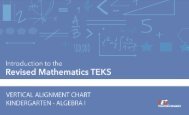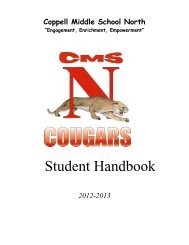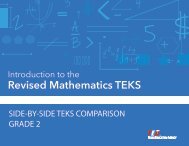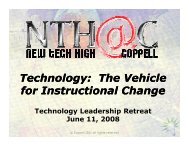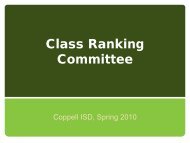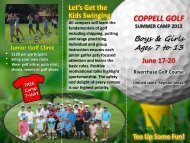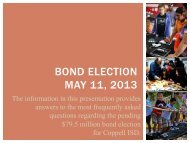SIDE-BY-SIDE TEKS COMPARISON GRADE 3 - Project Share
SIDE-BY-SIDE TEKS COMPARISON GRADE 3 - Project Share
SIDE-BY-SIDE TEKS COMPARISON GRADE 3 - Project Share
Create successful ePaper yourself
Turn your PDF publications into a flip-book with our unique Google optimized e-Paper software.
Grade 3 – MathematicsCurrent <strong>TEKS</strong>: Measurement Revised <strong>TEKS</strong> (2012) Supporting Information Notes+3(11)(E) Measurement. The student directlycompares the attributes of length, area,weight/mass, and capacity, and usecomparative language to solve problems andanswer questions. The student selects anduses standard units to describe length, area,capacity/volume, and weight/mass.3(7)(E) Geometry and measurement.Thestudent applies mathematical processstandards to select appropriate units,strategies, and tools to solve problemsinvolving customary and metricmeasurement.With the revised SE, students are notexpected to identify concrete models thatapproximate standard units of liquid volume(capacity).Students are measuring liquid volume(capacity).The student is expected to identifyconcrete models that approximatestandard units for capacity and use themto measure capacity.3(11)(F) Measurement. The student directlycompares the attributes of length, area,weight/mass, and capacity, and usecomparative language to solve problems andanswer questions. The student selects anduses standard units to describe length, area,capacity/volume, and weight/mass.The student is expected to determineliquid volume (capacity) or weight usingappropriate units and tools.Students are expected to use appropriateunits and tools to determine liquid volume(capacity) in the standard and metricsystems.–The student is expected to use concretemodels that approximate cubic units todetermine the volume of a givencontainer or other three-dimensionalgeometric figure.3(12)(A) Measurement. The student readsand writes time and measures temperature indegrees Fahrenheit to solve problems.The content of this SE was moved tograde 5:Geometry and measurement5(6)(A)5(6)(B)–The student is expected to use athermometer to measure temperature.This skill is not included explicitly within theRevised <strong>TEKS</strong> (2012).The skill of telling and writing time has movedto grade 2:Geometry and measurement2(9)(G)+3(12)(B) Measurement. The student readsand writes time and measures temperature indegrees Fahrenheit to solve problems.The student is expected to tell and writetime shown on analog and digital clocks.3(7)(C) Geometry and measurement.Thestudent applies mathematical processstandards to select appropriate units,strategies, and tools to solve problemsinvolving customary and metricmeasurement.The student is expected to determine thesolutions to problems involving additionand subtraction of time intervals inminutes using pictorial models or toolssuch as a 15-minute event plus a 30-minute event equals 45 minutes.When paired with 4(1)(C), students may beasked to use tools, such as analog and digitalclocks, to solve problems related to theaddition and subtraction of intervals of time inminutes.The revised SE 3(7)(C) builds to 4(8)(C).Students are expected to solve problemsinvolving intervals of time. With the length ofintervals provided, the focus is on theconversion of 60 minutes to an hour whenconsidering time intervals.©2013 Texas Education Agency. All Rights Reserved 2013 Introduction to the Revised Mathematics <strong>TEKS</strong>: Side-by-Side <strong>TEKS</strong> Comparison 16






